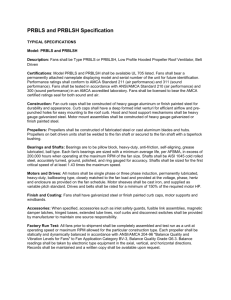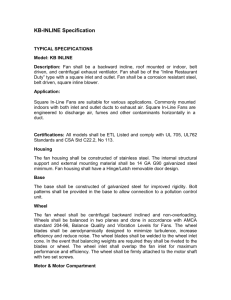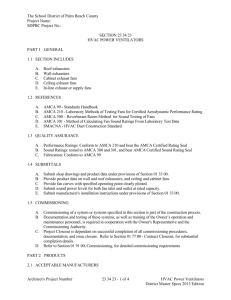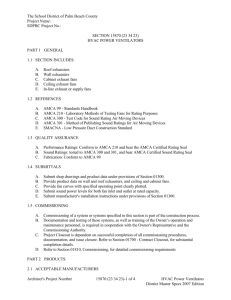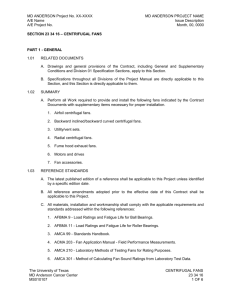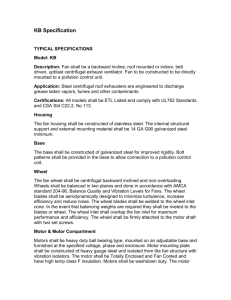doc - Stanford University
advertisement
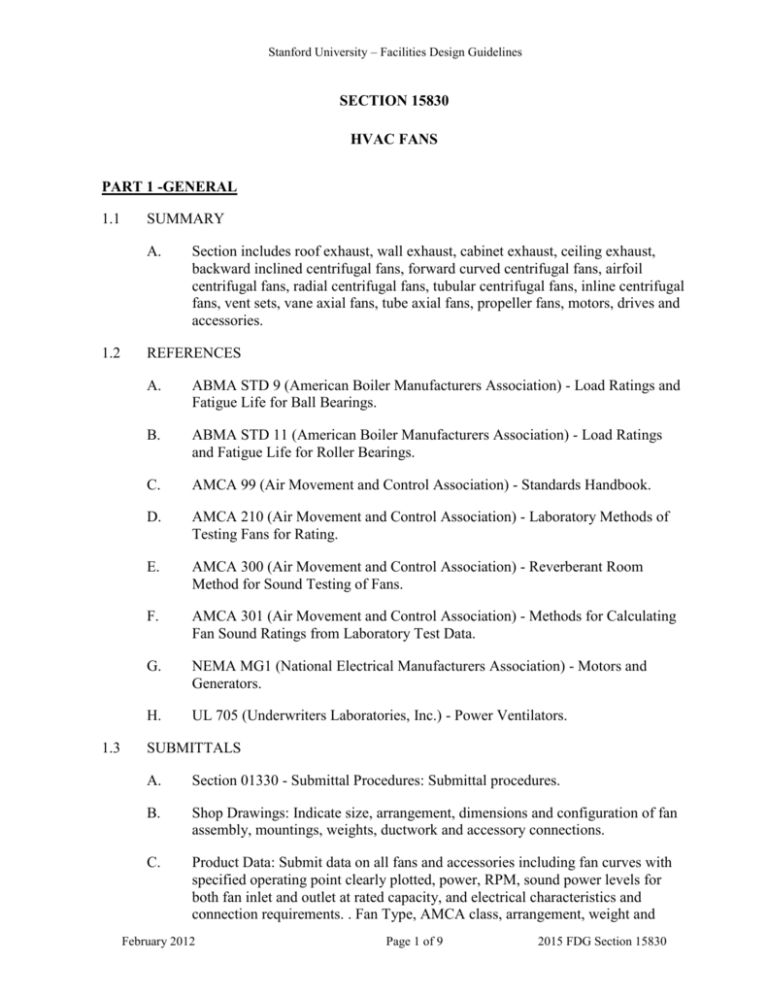
Stanford University – Facilities Design Guidelines SECTION 15830 HVAC FANS PART 1 -GENERAL 1.1 SUMMARY A. 1.2 1.3 Section includes roof exhaust, wall exhaust, cabinet exhaust, ceiling exhaust, backward inclined centrifugal fans, forward curved centrifugal fans, airfoil centrifugal fans, radial centrifugal fans, tubular centrifugal fans, inline centrifugal fans, vent sets, vane axial fans, tube axial fans, propeller fans, motors, drives and accessories. REFERENCES A. ABMA STD 9 (American Boiler Manufacturers Association) - Load Ratings and Fatigue Life for Ball Bearings. B. ABMA STD 11 (American Boiler Manufacturers Association) - Load Ratings and Fatigue Life for Roller Bearings. C. AMCA 99 (Air Movement and Control Association) - Standards Handbook. D. AMCA 210 (Air Movement and Control Association) - Laboratory Methods of Testing Fans for Rating. E. AMCA 300 (Air Movement and Control Association) - Reverberant Room Method for Sound Testing of Fans. F. AMCA 301 (Air Movement and Control Association) - Methods for Calculating Fan Sound Ratings from Laboratory Test Data. G. NEMA MG1 (National Electrical Manufacturers Association) - Motors and Generators. H. UL 705 (Underwriters Laboratories, Inc.) - Power Ventilators. SUBMITTALS A. Section 01330 - Submittal Procedures: Submittal procedures. B. Shop Drawings: Indicate size, arrangement, dimensions and configuration of fan assembly, mountings, weights, ductwork and accessory connections. C. Product Data: Submit data on all fans and accessories including fan curves with specified operating point clearly plotted, power, RPM, sound power levels for both fan inlet and outlet at rated capacity, and electrical characteristics and connection requirements. . Fan Type, AMCA class, arrangement, weight and February 2012 Page 1 of 9 2015 FDG Section 15830 Stanford University – Facilities Design Guidelines dimensions. Fan blade tip speed and maximum speed allowed. Provide material of construction, type of bearings, bearings life, motor horse power, voltage, amps, and motor type. Motor efficiency shall meet IEEE 841 premium efficiency standard. 1.4 1.5 1.6 1.7 1.8 1.9 D. Test Reports: Indicate performance data for adjustable axial fan blades for at least five blade settings, including maximum. E. Manufacturer's Installation Instructions: Submit fan manufacturer’s instructions. F. Manufacturer's Certificate: Certify that products meet or exceed specified requirements. CLOSEOUT SUBMITTALS A. Section 01770 - Execution Requirements: Closeout procedures. B. Operation and Maintenance Data: Submit instructions for lubrication, motor and drive replacement, spare parts list, and wiring diagrams. QUALIFICATIONS A. Manufacturer: Company specializing in manufacturing products specified in this section with minimum three years documented experience. B. Installer: Company specializing in performing work of this section with minimum three years documented experience. PRE-INSTALLATION MEETING A. Section 01330 - Administrative Requirements: Pre-installation meeting. B. Convene minimum two weeks prior to commencing work of this section. DELIVERY, STORAGE, AND HANDLING A. Factory Balance of fans: All fans shall be factory balanced to 2 mils or less. Each fan will have factory certification affixed to the fan. Certification will only be removed by Stanford’s commissioning officer after installation. B. Protect motors, shafts, and bearings from weather and construction dust. ENVIRONMENTAL REQUIREMENTS A. Store and protect equipment. B. Do not put fan into regular use for any purpose until ductwork is clean, filters are in place, bearings lubricated, and fan has been test run under observation. FIELD MEASUREMENTS A. Verify field measurements prior to fabrication. February 2012 Page 2 of 9 2015 FDG Section 15830 Stanford University – Facilities Design Guidelines 1.10 1.11 1.12 WARRANTY A. Section 01770 - Execution Requirements: Product warranties and product bonds. B. Provide a minimum of one year manufacturer’s warranty for fans. MAINTENANCE SERVICE A. Section 01770 - Execution Requirements: Maintenance service. B. Provide service and maintenance of fans for one year from Date of Occupancy. EXTRA MATERIALS A. Section 01770 - Execution Requirements: Spare parts and maintenance products. PART 2 -PRODUCTS 2.1 CENTRIFUGAL FANS A. Fans shall be New York Blower, Trane Company, Greenheck, or approved equal. B. Fanwall by Huntair will be considered as an alternate when low noise is critical. C. Performance 1. 2. 3. 4. 5. 6. 7. 8. D. Performance Ratings: Conform to AMCA 210 and bear the AMCA Certified Rating Seal. Sound Ratings: AMCA 301, tested to AMCA 300, and bear AMCA Certified Sound Rating Seal. Fabrication: Conform to AMCA 99 and 210. Performance Base: Sea level conditions. Temperature Limit: Maximum per design. Static and Dynamic Balance: Eliminate vibration or noise transmission to occupied areas. Air Flow: Per design on drawings and/or specifications Static Pressure: Per design. Wheel and inlet 1. 2. February 2012 Backward Inclined: Steel construction with smooth curved inlet flange, heavy back plate, backward curved blades welded to flange and back plate; cast iron or cast steel hub riveted to back plate and keyed to shaft with set screws. Forward Curved: Black enamel or Galvanized, per design, steel construction with inlet flange, back plate, shallow blades with inlet and tip curved forward in direction of airflow, mechanically secured to flange and back plate; steel hub swaged to back plate and keyed to shaft with set screw. Page 3 of 9 2015 FDG Section 15830 Stanford University – Facilities Design Guidelines 3. 4. E. Housing 1. 2. 3. 4. F. Steel, spot welded for AMCA 99 Class I and II fans, and continuously welded for Class III, braced, designed to minimize turbulence with spun inlet bell and shaped cut-off. Factory finish before assembly to manufacturer's standard. For fans handling air downstream of humidifiers, provide two additional coats of paint, fabricate of galvanized steel. Prime coating on aluminum parts is not required. Provide bolted construction with horizontal flanged split housing, where indicated. Fabricate plug fans without volute housing, in lined steel cabinet. Bearings and Sheaves 1. 2. 3. 4. G. Airfoil Wheel: Steel construction with smooth curved inlet flange, heavy back plate die formed hollow airfoil shaped blades continuously welded at tip flange, and back plate; cast iron or cast steel hub riveted to back plate and keyed to shaft with set screws. Radial: Steel construction with inlet flange, heavy reinforced back plate, plate blades with reinforcing gussets and wearing strips welded cast iron or cast steel hub riveted to back plate and keyed to shaft with set screws. Bearings: pillow block type, self-aligning, grease-lubricated ball bearings, with ABMA 9 L-10 life at 50,000 hours L-50 life at 100,000 hours roller bearings, or ABMA 11, L-10 life at 120,000 hours L-50 life at 400,000 hours per design. Shafts: Precision shafting stock, ground and polished, with key way, protectively coated with lubricating oil, and shaft guard. V-Belt Drive: Steel sheaves, dynamically balanced, keyed. Variable and adjustable pitch sheaves for motors without a VFD, selected so required rpm is obtained with sheaves set at mid-position. Fixed sheave for 20 hp and over, matched belts, and drive rated as recommended by manufacturer or minimum 1.5 times nameplate rating of the motor. For balancing only. Only fan system is balanced. Fixed steel sheaves will be installed. Solid sheave for fans with a VFD. Belt Guard: Fabricate to SMACNA Standard; 0.106 inch thick, ¾ inch diamond mesh wire screen welded to steel angle frame or equivalent, prime coated. Secure to fan or fan supports without short circuiting vibration isolation, with provision for adjustment of belt tension, lubrication, and use of tachometer with guard in place. Accessories 1. 2. 3. 4. February 2012 Inlet/Outlet Screens: Galvanized steel welded grid. Access Doors: Shaped to conform to scroll, with quick opening latches and gaskets. Scroll Drain: ½ inch steel pipe coupling welded to low point of fan scroll. Vibration Monitoring Module: Continuous vibration monitoring device module shall be installed in an open area allowing for safe maintenance Page 4 of 9 2015 FDG Section 15830 Stanford University – Facilities Design Guidelines access. The transducers shall be connected to the outboard bearing and on the belt side bearing. Alarm output shall be sent to BMS/Delta V monitoring system and coordinated with LBRE/FESO. Manufacturer: SPM Instruments Parts Numbers: a) VMM – 21 Vibration Monitoring Module b) SLD121F Vibration Transducers H. Electrical Characteristics and Components. 1. 2.2 Disconnect Switch: Factory mount in control panel or on equipment. AXIAL FANS A. Product Requirements: 1. 2. 3. 4. 5. B. Hub and Impeller: 1. 2. 3. 4. C. Airfoil Impeller Blades: Adjustable welded steel die formed blades with belt drive. Hub: Die cast aluminum alloy or cast iron hub or with belt drive of spun, welded steel, bored and keyed to shaft; to facilitate indexing of blade angle with manual or automatic adjustment stops. Controllable Pitch Assemblies: Incorporate ball bearing counterbalanced blade and variable pitch assembly into hub with mechanical link to casing exterior mounted actuator, or pneumatic or electric actuator incorporated within hub. Cast Components: X-ray components after fabrication and statically and dynamically balance assembly before attachment to motor or shaft. Casing: 1. 2. 3. D. Performance Ratings: Conform to AMCA 210 and bear the AMCA Certified Rating Seal. Sound Ratings: AMCA 301, tested to AMCA 300, and bear AMCA Certified Sound Rating Seal. Fabrication: Conform to AMCA 99. Performance Base: Sea level conditions. Temperature Limit: Maximum per design. Fabricate casing of minimum 1/4 inch steel for fans 40inch in diameter and smaller and 3/8 inch steel for larger fans. Continuously weld, with inlet and outlet flange connections, and motor or shaft supports. Incorporate flow straightening guide vanes for fans specified for static pressures greater than one inch wg. Finish with one coat enamel applied to interior and exterior or by hot dip galvanizing finished assembly per application. Bearings and Drives: February 2012 Page 5 of 9 2015 FDG Section 15830 Stanford University – Facilities Design Guidelines 1. 2. 3. 4. 5. E. Accessories: 1. 2. 3. 4. 5. 6. F. Inlet Bell: Bell mouth inlet fabricated of steel, aluminum, fiberglass reinforced plastic with flange per application or design. Outlet Cones: Fabricated of steel with flanges, outlet area/inlet area ratio of 1.5/1.0, with center pod as recommended by manufacturer. Inlet Screens: Galvanized steel welded grid to fit inlet bell. Dampers: Welded steel construction, consisting of two semi-circular vanes pivoted on oil-retaining bearings in short casing section, finished with one coat enamel by hot dip galvanizing. Provide air stream operation closing blades by reverse airflow and gravity hand operation with hand wheel control of screw and link mechanism motor actuation. Access Doors: Shaped to conform to casing with quick opening latches and gaskets. Vibration Detector: Factory installed vibration switch to stop fan with extra set of contacts per Stanford requirements. Electrical Characteristics and Components 1. 2.3 Bearings: Heavy-duty pillow block type, self-aligning, grease-lubricated ball bearings, with ABMA 9 L-10 life at 50,000 hours, L-50 life at 100,000 hours roller bearings, or ABMA 11, L-10 life at 120,000 hours, L-50 life at 400,000 hours, per application. Shafts: Hot rolled steel, ground and polished, with keyway, protectively coated with lubricating oil. V-Belt Drive: Cast iron or steel sheaves, dynamically balanced, keyed. Variable and adjustable pitch sheaves for fans without a VFD, during balancing only so, required rpm is obtained with sheaves set at midposition; fixed sheave for 20 hp and over, matched belts, and drive rated as recommended by manufacturer or minimum 1.5 times nameplate rating of the motor. Solid sheave for fans with a VFD. Belt Guard: Fabricate to SMACNA Standards; 0.106 inch thick, ¾ inch diamond mesh wire screen welded to steel angle frame or equivalent, prime coated. Secure to fan or fan supports without short circuiting vibration isolation, with provision for adjustment of belt tension, lubrication, and use of tachometer with guard in place. Lubrication: Extend lubrication fittings to outside of casing. Disconnect Switch: Factory mount in control panel or on equipment. PROPELLER FANS A. Greenheck, Cook, Strobic Air Corp, or approved equal. B. Construction. 1. February 2012 Impeller: Shaped steel or steel reinforced aluminum blade with heavy hubs, statically and dynamically balanced, keyed and locked to shaft, directly connected to motor or provided with V-belt drive per design. Page 6 of 9 2015 FDG Section 15830 Stanford University – Facilities Design Guidelines 2. C. Accessories: 1. 2. 3. 4. 5. D. Back-draft Damper: Multiple blades with offset hinge pin, blades linked. Outlet Damper: Multiple blades with offset hinge pin, blades linked, line voltage motor drive, power open, spring return. Safety Screens: Expanded galvanized metal over inlet, motor, and drive and outlet; comply with OSHA regulations. Hood: Weather shield, to exclude rain and snow. Controller: Variable frequency driver. Electrical Characteristics and Components 1. 2.4 Frame: One piece, square steel with die formed venturi orifice, mounting flanges and supports, with baked enamel finish. Disconnect Switch: Factory mount in control panel or on equipment. ROOF VENTILATORS A. Green Heck, Cook, or approved equal. B. Product Requirements: 1. 2. 3. 4. C. Construction 1. 2. D. Performance Ratings: Conform to AMCA 210 and bear the AMCA Certified Rating Seal. Sound Ratings: AMCA 301, tested to AMCA 300, and bear AMCA Certified Sound Rating Seal. Fabrication: Conform to AMCA 99. UL Compliance: UL listed and labeled, designed, manufactured, and tested in accordance with UL 705. Fan Unit: V-belt or direct driven as indicated, with spun aluminum galvanized steel with baked-on enamel, fiberglass reinforced plastic, up blast spun aluminum with grease tray, housing; resilient mounted motor; ½ inch mesh, 0.62 inch thick aluminum wire bird screen; square base to suit roof curb with continuous curb gaskets. Sheaves: Cast iron or steel, dynamically balanced, bored to fit shafts and keyed; variable and adjustable pitch motor sheave selected so required rpm is obtained with sheaves set at mid-position; fan shaft with selfaligning re-lubricable ball bearings. Accessories 1. February 2012 Roof Curb: 12 inch high self-flashing galvanized steel aluminum with continuously welded seams, built-in cant strips, one inch insulation and curb bottom, interior baffle with acoustic insulation, curb bottom, ventilated double wall, hinged curb adapter, and factory installed nailer strip. Page 7 of 9 2015 FDG Section 15830 Stanford University – Facilities Design Guidelines 2. E. Electrical Characteristics and Components 1. 2.5 Disconnect Switch: Factory-wired, non-fusible, in housing for thermal overload protected motor and wall mounted multiple speed switch or solid state speed controller. WALL EXHAUST FANS A. Penn Ventilation, Green Heck or approved equal. B. Construction 1. 2. C. Fan Unit: V-belt or direct driven with spun aluminum housing; resiliently mounted motor; ½ inch mesh, 0.062 inch thick aluminum wire bird screen. Sheaves: For V-belt drives, provide cast iron or steel, dynamically balanced, bored to fit shafts and keyed; variable and adjustable pitch motor sheaves selected so required rpm is obtained with sheaves set at mid-position; fan shaft with self-aligning pre-lubricated ball bearings. Accessories 1. 2. 2.6 Back-draft Damper: Gravity actuated, aluminum multiple blade construction, felt edged with offset hinge pin, nylon bearings, blades linked and line voltage motor drive, power open, spring return. Disconnect Switch: Factory wired, non-fusible, in housing for thermal overload protected motor and wall mounted multiple speed switch or solid state speed controller, per design. Back-draft Damper: Gravity actuated, aluminum multiple blade construction, felt edged with offset hinge pin, nylon bearings, blades linked and line voltage motor drive, power open, spring return. CABINET AND CEILING EXHAUST FANS A. Construction 1. 2. 3. B. Centrifugal Fan Unit: V-belt or direct driven with galvanized steel housing lined with ½ inch acoustic insulation, resilient mounted motor, gravity back-draft damper in discharge. Grille: Molded white plastic, Aluminum with baked white enamel finish. Sheaves: Cast iron or steel, dynamically balanced, bored to fit shafts and keyed; variable and adjustable pitch motor sheaves selected so required rpm is obtained with sheaves set at mid-position; fan shaft with selfaligning pre-lubricated ball bearings. Electrical Characteristics and Components 1. February 2012 Disconnect Switch: Cord and plug in housing for thermal overload protected motor and wall mounted switch multiple speed switch solid state speed controller. Page 8 of 9 2015 FDG Section 15830 Stanford University – Facilities Design Guidelines PART 3 -EXECUTION 3.1 INSTALLATION A. Do not put fans into normal use for any purpose until ductwork is clean, filters are in place, bearings lubricated, and fan has been test run under observation. B. Install fans as indicated, with resilient mountings and flexible electrical leads. C. Install flexible connections as specified elsewhere between fan inlet and discharge ductwork. Ensure metal bands of connectors are parallel with minimum one inch flex between ductwork and fan while running. D. Install fan restraining snubbers as specified elsewhere. Flexible connectors shall not be in tension while running. E. Provide sheaves required for final air balance. F. Provide safety screen where inlet or outlet is exposed. G. Pipe scroll drains to nearest floor drain. H. Provide backdraft dampers on discharge of general exhaust fans. END OF SECTION February 2012 Page 9 of 9 2015 FDG Section 15830
